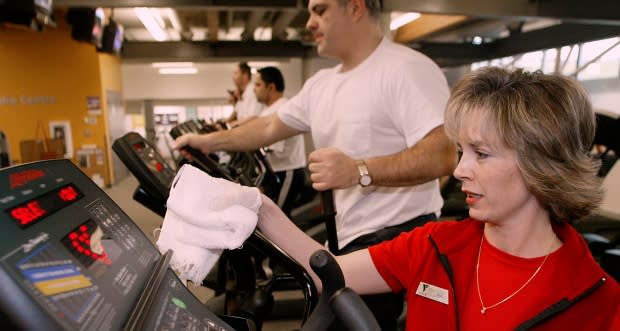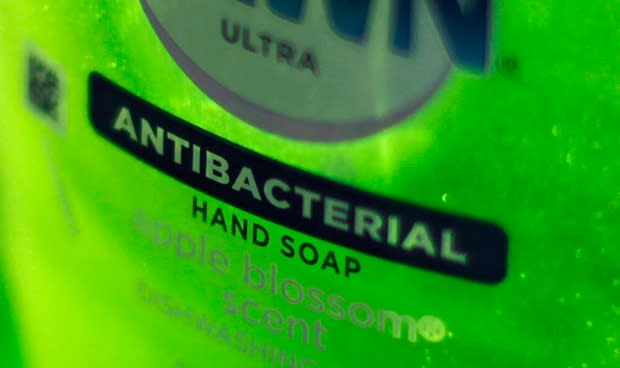Microbes that live at the gym are pumped up on antibiotic resistance
When environmental engineer Erica Hartmann hits the gym, she sees the floor where people lie down to do crunches as the perfect place to test dust for microbes.
You may think of dust as dead. But dust actually teems with bacteria because it acts as a final resting place for everything drifting through the air.
At a gym, people are often encouraged to wipe down the weights and machines with a sanitizer. One antimicrobial ingredient called triclosan stops the growth of bacteria, fungus and mildew as well as deodorizes.
Manufacturers add triclosan to a variety of products, such as antibacterial soap, knife handles and textiles.
"What's happening to the bacteria in dust with all the antimicrobial chemicals?" Hartmann wondered.
In a new study, she and her team at Northwestern University in Illinois discovered dust in gyms is not only alive, but shows signs of antibiotic resistance.

The scientists first took samples of vacuum-collected dust from gyms at 42 athletic facilities in Oregon, including private fitness clubs, public recreation centres and studios for dance, yoga and martial arts.
Hartmann and her colleagues were able to grow more than 7,000 colonies of different types of bacteria. "I was a little overwhelmed" at the result, she said.
In Tuesday's issue of the journal mSystems, Hartmann reported about 30 per cent of the bacteria were resistant to one of three medically relevant antibiotic drugs.
About 100 years ago, infectious diseases were one of the leading causes of death. Now, thanks to proper sanitation of water and antibiotic drugs, infectious diseases are way down the list of top killers in Canada.
Hartmann suspects we've swung too far when it comes to sanitation. It's overkill, she says, like building an atomic bomb to go after one bad germ.
Antibacterial resistance happens when drugs kill some bacteria, but not all of them. Some remaining bugs evolve ways to protect themselves and thrive. When that occurs, people can develop infections that are much harder to treat.

When scientists first synthesized new compounds, it was assumed that the chemicals would be inactive in the environment. Hartmann said scientists are just starting to appreciate the full consequences of synthesizing chemicals, such as how they can affect microbial ecosystems.
When we introduce synthetic chemicals such as triclosan, she says, the bacteria see a ready-made food source to exploit. "Bacteria are just trying to make a living."
The study doesn't prove triclosan causes antibiotic resistance. The researchers found genetic markers indicating antibiotic resistance in general, not resistance to triclosan specifically. Nonetheless, "the associations we see are quite suspicious," Hartmann said.
When triclosan is used in personal care products, it leaves a long-lasting residue on indoor dust. Overall, the residues at the gym aren't a major threat, she said. "If you compare antibiotic resistance in any environment compared with the human gut, there's way more in the human gut."
If a patient in an industrialized country develops an antibiotic resistant infection while in hospital, those infections are tracked by governments and the World Health Organization. But infections acquired outside of a health-care facility often don't get reported, so it's hard to say what infections are coming from where and what the true cause is, Hartmann said.
That's why the overall magnitude of the problem of antibiotic resistance traced to dust is unknown.
Soap and water recommended
But given how antibiotic resistance is a huge threat to public health right now, she has a suggestion for consumers: "Antibiotic hand soap is not necessary. Regular soap and water is perfectly fine."
Until 2017 in the U.S., manufacturers commonly added triclosan to antibacterial hand soap and cleaning solutions. The U.S. Food and Drug Administration banned companies from selling antibacterial hand washes with triclosan because the manufacturers didn't prove the ingredients "are both safe for long-term daily use and more effective than plain soap and water in preventing illness and the spread of certain infections."
In 2012, Health Canada and Environment Canada reviewed triclosan and proposed that industry voluntarily cut the amount it uses, particularly in personal-care products that tend to get rinsed away into lakes and rivers.
In the U.S., triclosan is still found in wipes people use at the gym as well as in toothpaste and many consumer products like cutting boards and toys that aren't necessarily labelled because the products are regulated by the Environmental Protection Agency, not the FDA.
Environment Canada deems triclosan highly toxic to a variety of aquatic organisms, such as algae and fish, as well as to certain soil organisms.
"At current levels of exposure, triclosan is not harmful to human health," the Canadian government reiterated last month.
The federal government proposed a pollution prevention plan to limit the presence of triclosan in Canadian waterways. The proposal is open to public comments until Jan. 23, a spokesperson for Health Canada said.
Fears of bacteria overblown
Hartmann said if triclosan affects ecosystems, it will eventually affect human health. Regulators typically evaluate substances by acute toxicity, such as how much you can feed a rat before it keels over and dies.
She'd like to see regulators pay more attention to potentially chronic effects of chemicals that could take decades to appear, particularly in the case of microbial ecosystems that influence antibiotic resistance and eventually human health.
"My position has always been that [triclosan] is unnecessary in a home and that we shouldn't be using such potent chemicals to assuage our fears of bacteria," said Dr. Kapil Khatter, a family physician in Ottawa and formerly executive director of the Canadian Association of Physicians for the Environment.
He said triclosan makes sense where sterility is essential, such as in health-care settings, but not for broader use in households or gyms.
Researchers at the University of Oregon, Arizona State University, the Santa Fe Institute and Harvard also worked on the study.
The research was partially supported by the Alfred P. Sloan Foundation, a philanthropic non-profit organization established by the former head of General Motors.

